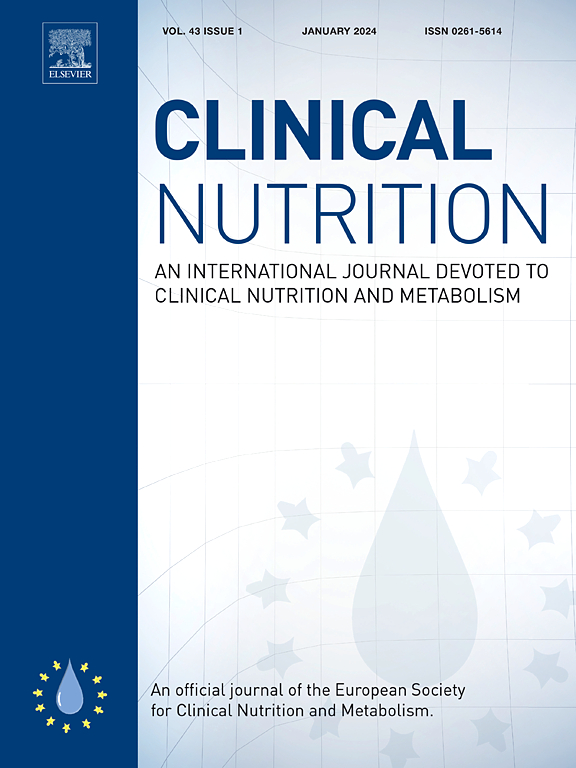肥胖症患者身体成分的改变:患病率、相关因素和两种方法的比较。
IF 6.6
2区 医学
Q1 NUTRITION & DIETETICS
引用次数: 0
摘要
背景与目的:对于肌少性肥胖的最佳诊断方法,特别是身体成分改变的诊断方法,仍存在一些不确定性。最近的一项国际共识提出了脂肪量增加(FM)与体重调整的骨骼肌量减少(SMM/W)(方法1)的关联。脂肪质量指数(FMI)/无脂肪质量指数(FFMI)的比率(方法2)也被提出。目的:确定和比较两种方法在转诊到专门中心的肥胖患者中改变身体成分的患病率及其相关因素。方法:收集人体测量、单频生物阻抗分析(BIA)和肌肉减少症的危险因素。根据Janssen方程计算SMM和FMI/FFMI比值。两种方法的一致性由kappa系数决定。根据两种方法,多变量分析确定了与身体成分改变相关的因素。结果:回顾性纳入253例连续患者:81%为女性,年龄44.4±13岁,体重指数(BMI) 43.0±6.8 kg/m2,重度肥胖,94%。方法1中90%的肥胖患者(227/253)体成分发生改变,方法2中35%(83/253)体成分发生改变。两种方法的一致性很低(kappa = 0.10)。与体成分改变相关的因素有:方法1,年龄(优势比= 1.05[95%可信区间,1.01;1.10], P = 0.02),动脉高血压(0.18 [0.06;0.57], P = 0.04),臀围(1.13 [1.07;[1.20], P结论:体成分改变在重度肥胖患者中较为常见。这两种方法不可比较。进一步的工作将致力于改进肥胖患者的身体成分测量方法,特别是对肌肉减少型肥胖的诊断。本文章由计算机程序翻译,如有差异,请以英文原文为准。
Altered body composition in obesity: Prevalence, associated factors and comparison of two methods
Background & aims
There is still some uncertainty towards the best method to diagnose the sarcopenic obesity, and specifically, altered body composition. A recent international consensus proposes the association of increased fat mass (FM) with reduced skeletal muscle mass adjusted by weight (SMM/W) (method 1). The ratio of fat mass index (FMI)/fat free mass index (FFMI) (method 2) has also been proposed. Aims: to determine and compare the prevalence of altered body composition by the two methods, and its associated factors, in obese patients referred to a specialized center.
Methods
Anthropometry, single-frequency bioimpedance analysis (BIA), and risk factors for sarcopenia were collected. SMM, according to the Janssen equation, and the FMI/FFMI ratio, were calculated. The agreement between the two methods was determined by the kappa coefficient. Multivariable analysis identified the factors associated with altered body composition according to the two methods.
Results
253 consecutive patients were retrospectively included: 81 % women, age 44.4 ± 13 yr, body mass index (BMI) 43.0 ± 6.8 kg/m2, severe obesity, 94 %. Altered body composition was reported in 90 % of the obese patients (n = 227/253) with method 1, and 35 % (83/253) with method 2. The agreement between the two methods was very low (kappa = 0.10). The factors associated with altered body composition were: method 1, age (odds ratio = 1.05 [95 % confidence interval, 1.01; 1.10], P = 0.02), arterial hypertension (0.18 [0.06; 0.57], P = 0.04), hip circumference (1.13 [1.07; 1.20], P < 0.0001), previous obesity follow-up (3.78 [1.30; 10.96], P = 0.002); method 2, female gender (3.12 [1.02; 9.5], P = 0.04), age (1.10 [1.06; 1.14], P < 0.0001), BMI (1.37 [1.26; 1.50], P < 0.0001), history of cancer (5.35 [1.20; 23.84], P < 0.028), phase angle (0.42 [0.27; 0.66], P < 0.001).
Conclusion
Altered body composition is common in severely obese patients. The two methods are not comparable. Further work will aim at refining the methods of body composition measurements in the obese patients, and especially for the sarcopenic obesity diagnosis.
求助全文
通过发布文献求助,成功后即可免费获取论文全文。
去求助
来源期刊

Clinical nutrition
医学-营养学
CiteScore
14.10
自引率
6.30%
发文量
356
审稿时长
28 days
期刊介绍:
Clinical Nutrition, the official journal of ESPEN, The European Society for Clinical Nutrition and Metabolism, is an international journal providing essential scientific information on nutritional and metabolic care and the relationship between nutrition and disease both in the setting of basic science and clinical practice. Published bi-monthly, each issue combines original articles and reviews providing an invaluable reference for any specialist concerned with these fields.
 求助内容:
求助内容: 应助结果提醒方式:
应助结果提醒方式:


